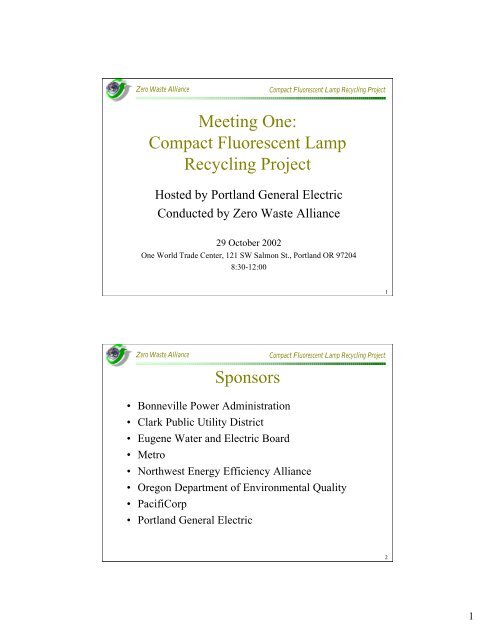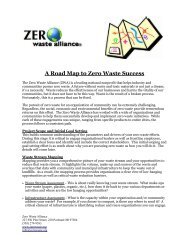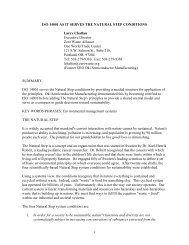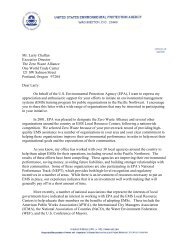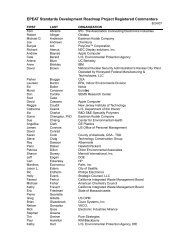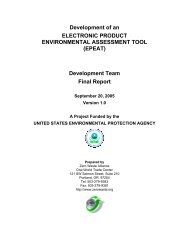CFL Meeting 1 Presentation Slides - the Zero Waste Alliance
CFL Meeting 1 Presentation Slides - the Zero Waste Alliance
CFL Meeting 1 Presentation Slides - the Zero Waste Alliance
Create successful ePaper yourself
Turn your PDF publications into a flip-book with our unique Google optimized e-Paper software.
<strong>Zero</strong> <strong>Waste</strong> <strong>Alliance</strong><br />
Compact Fluorescent Lamp Recycling Project<br />
<strong>Meeting</strong> One:<br />
Compact Fluorescent Lamp<br />
Recycling Project<br />
Hosted by Portland General Electric<br />
Conducted by <strong>Zero</strong> <strong>Waste</strong> <strong>Alliance</strong><br />
29 October 2002<br />
One World Trade Center, 121 SW Salmon St., Portland OR 97204<br />
8:30-12:00<br />
1<br />
<strong>Zero</strong> <strong>Waste</strong> <strong>Alliance</strong><br />
Sponsors<br />
Compact Fluorescent Lamp Recycling Project<br />
• Bonneville Power Administration<br />
• Clark Public Utility District<br />
• Eugene Water and Electric Board<br />
• Metro<br />
• Northwest Energy Efficiency <strong>Alliance</strong><br />
• Oregon Department of Environmental Quality<br />
• PacifiCorp<br />
• Portland General Electric<br />
2<br />
1
<strong>Zero</strong> <strong>Waste</strong> <strong>Alliance</strong><br />
Compact Fluorescent Lamp Recycling Project<br />
O<strong>the</strong>r Participants<br />
• Lane County <strong>Waste</strong> Management<br />
• Marion County Public Works<br />
• National Electrical Manufacturers Association<br />
• Total Reclaim / EcoLights Northwest<br />
• Earth Protection Services<br />
• Environmental Protection Services<br />
• Association of Oregon Recyclers<br />
• Oregon Refuse and Recycling Association<br />
• Ecos Consulting<br />
• EcoNorthwest Consulting<br />
• Retailers (Ace, True Value, Do It Best - Hardware)<br />
• <strong>Waste</strong> Management of Oregon<br />
• Citizen Stakeholder<br />
3<br />
<strong>Zero</strong> <strong>Waste</strong> <strong>Alliance</strong><br />
Compact Fluorescent Lamp Recycling Project<br />
Agenda<br />
• <strong>CFL</strong> Project Description<br />
• <strong>CFL</strong>s<br />
• Current Situation<br />
• Recycling Program Options<br />
• Case Studies<br />
• Potential Program Models<br />
• Break<br />
• Discussion of Models and Payment Options<br />
• Funding of Pilot Project<br />
• Wrap-up / Next Steps<br />
4<br />
2
<strong>Zero</strong> <strong>Waste</strong> <strong>Alliance</strong><br />
Compact Fluorescent Lamp Recycling Project<br />
Purpose of <strong>CFL</strong> Project<br />
• To provide a multi stakeholder process for planning a<br />
state/region wide <strong>CFL</strong> recycling program model<br />
• To evaluate alternative <strong>CFL</strong> recycling models<br />
• To encourage <strong>the</strong> safe use of energy efficient products<br />
• To increase economic activity from <strong>CFL</strong> recycling<br />
• To reduce amounts of one of <strong>the</strong> sources of Hg to<br />
landfills<br />
• To protect <strong>the</strong> environment for human and ecosystem<br />
health<br />
5<br />
<strong>Zero</strong> <strong>Waste</strong> <strong>Alliance</strong><br />
Compact Fluorescent Lamp Recycling Project<br />
Principles<br />
• Environmental Protection<br />
• Easy Access<br />
• Low Cost<br />
• Fair Cost Allocation<br />
• Compliance<br />
• Education<br />
• Replicable<br />
• Expandable<br />
• Recycling System<br />
• Sustainable<br />
6<br />
3
<strong>Zero</strong> <strong>Waste</strong> <strong>Alliance</strong><br />
Compact Fluorescent Lamp Recycling Project<br />
• Background<br />
• Purpose<br />
Charter<br />
• Objectives<br />
• Proposed General Guidelines for <strong>Meeting</strong>s<br />
• Consensus Process<br />
• Sponsors and Conveners<br />
7<br />
<strong>Zero</strong> <strong>Waste</strong> <strong>Alliance</strong><br />
Compact Fluorescent Lamp Recycling Project<br />
Project Phases<br />
• Phase I<br />
– Research <strong>CFL</strong>s sold, methods of collection and<br />
payment, and existing recycling programs<br />
– Draft report<br />
• Phase II<br />
– Pilot project design<br />
– Scope of larger recycling program<br />
• Phase III<br />
– Implement and operate pilot project<br />
8<br />
4
<strong>Zero</strong> <strong>Waste</strong> <strong>Alliance</strong><br />
Compact Fluorescent Lamp Recycling Project<br />
Objectives of <strong>Meeting</strong>s<br />
• Agree on concepts and goals of pilot and larger recycling<br />
program<br />
• Determine <strong>the</strong> optimum form for one or more pilot recycling<br />
programs<br />
• Establish scope of administration for pilot<br />
• Select <strong>CFL</strong> collection and recycling location(s) and participants<br />
for pilot<br />
• Determine budget and revenues needed to support pilot<br />
• Determine public input and education needed<br />
• Develop marketing approach / strategy<br />
• Develop program metrics for tracking and reporting<br />
• Discuss future actions for larger program after conclusion of<br />
pilot<br />
9<br />
<strong>Zero</strong> <strong>Waste</strong> <strong>Alliance</strong><br />
Benefits of <strong>CFL</strong>s and<br />
Environmental Issues<br />
• Benefits<br />
– Energy efficient (=P2)<br />
– Long life span<br />
– Long term economic payback<br />
– Longer time between replacement<br />
– Aes<strong>the</strong>tic swirl design<br />
• Environmental Issues<br />
– Mercury<br />
– Need to recycle properly<br />
Compact Fluorescent Lamp Recycling Project<br />
10<br />
5
<strong>Zero</strong> <strong>Waste</strong> <strong>Alliance</strong><br />
Compact Fluorescent Lamp Recycling Project<br />
<strong>CFL</strong> Recycling Process<br />
• <strong>CFL</strong>s/tubes received in safety container<br />
• Crushed under negative pressure to capture gas<br />
and particulates<br />
• Phosphorous powder (containing Hg) pulled by<br />
vacuum and stored in drum<br />
• Glass and metals separated, sent to secondary<br />
recycling<br />
• Powder processed by retorting device to separate<br />
Hg, resulting in semi-pure metallic Hg<br />
12<br />
<strong>Zero</strong> <strong>Waste</strong> <strong>Alliance</strong><br />
Compact Fluorescent Lamp Recycling Project<br />
Regulations affecting <strong>CFL</strong>s<br />
• Households<br />
• no regulations, but limited #s and frequency to solid waste<br />
• Subject to local waste authorities rules (25 per collection)<br />
• Businesses<br />
– Conditionally Exempt Generators<br />
• 11,000 lbs.)<br />
• Fluorescents are universal waste; go to destination facilities<br />
• Destination facilities<br />
• Lamps subject to hazardous waste requirements<br />
• Hazardous waste landfills or lamp recycling facilities<br />
13<br />
6
<strong>Zero</strong> <strong>Waste</strong> <strong>Alliance</strong><br />
Compact Fluorescent Lamp Recycling Project<br />
NOTE:<br />
• The data, information, and assumptions contained in this<br />
presentation were to serve only as a starting point for<br />
facilitating discussion in <strong>the</strong> <strong>CFL</strong> Stakeholders Group<br />
meetings.<br />
• It is expected that assumptions and estimates may change<br />
as potential programs are fur<strong>the</strong>r developed. A formal<br />
project proposal is needed from <strong>the</strong> organization that will<br />
manage <strong>the</strong> potential recycling programs in order to more<br />
accurately estimate costs.<br />
14<br />
<strong>Zero</strong> <strong>Waste</strong> <strong>Alliance</strong><br />
Compact Fluorescent Lamp Recycling Project<br />
• Sales (Source: NEEA)<br />
<strong>CFL</strong> Sales<br />
Previous Years <strong>CFL</strong> Sales<br />
1997 1998 1999 2000 2002 projected Future avg/yr<br />
<strong>CFL</strong>s 204,000 160,830 255,031 528,159<br />
Fixtures 76,393 69,400 50,822<br />
Total 204,000 237,223 324,431 578,980 2,500,000 1,000,000<br />
15<br />
7
<strong>Zero</strong> <strong>Waste</strong> <strong>Alliance</strong><br />
Compact Fluorescent Lamp Recycling Project<br />
<strong>CFL</strong> Distribution<br />
• Distribution – Sales, coupon and distribution program data<br />
(Source: EcoNorthwest; Based on region totals distributed over population per state)<br />
<strong>CFL</strong> Distribution - Q4 2000-Q4 2001<br />
Distribution Source Total OR WA ID<br />
Non-Coupon Sales 4,200,976 1,353,148 2,333,119 514,709<br />
PGE Coupon Sales 1,750,000 1,750,000<br />
PacifiCorp Distribution 799,007 608,713 190,294<br />
Coupon Sales (excluding PGE) 889,570<br />
King County Giveaway 412,350 412,350<br />
O<strong>the</strong>r Giveaway Programs 402,900 52,000 312,900 38,000<br />
TOTAL 8,454,803 3,763,861 3,248,663 552,709<br />
16<br />
<strong>Zero</strong> <strong>Waste</strong> <strong>Alliance</strong><br />
Compact Fluorescent Lamp Recycling Project<br />
Projected Failures<br />
• Projected failures (Based on sales data assuming 50% failure in 4 yrs,<br />
and 100% in 7 yrs)<br />
Estimated <strong>CFL</strong> Burn Outs/Year in <strong>the</strong> Northwest<br />
3,000,000<br />
2,500,000<br />
2,000,000<br />
1,500,000<br />
1,000,000<br />
500,000<br />
0<br />
1997<br />
1998<br />
1999<br />
2000<br />
2001<br />
# of burn outs<br />
2002<br />
2003<br />
2004<br />
2005<br />
2006<br />
2007<br />
2008<br />
2009<br />
2010<br />
2011<br />
2012<br />
Year<br />
17<br />
8
<strong>Zero</strong> <strong>Waste</strong> <strong>Alliance</strong><br />
Compact Fluorescent Lamp Recycling Project<br />
Collection and Recycling<br />
• Current collection of <strong>CFL</strong>s for Recycling<br />
– Household Hazardous <strong>Waste</strong><br />
• Metro ~ 600 / yr<br />
• Salem transfer ~ 100 / yr<br />
• Lane County ~ 80 / yr<br />
• DEQ HHW no data<br />
– Recyclers (majority of <strong>CFL</strong>s not from households)<br />
• Earth Protection Services ~ 7,442 in 2001<br />
• Environmental Protection Services ~ 4-5,000 in 2001<br />
• EcoLights Northwest ~ 3,000 in 2001<br />
18<br />
<strong>Zero</strong> <strong>Waste</strong> <strong>Alliance</strong><br />
Compact Fluorescent Lamp Recycling Project<br />
<strong>CFL</strong> Product Flow<br />
Point of<br />
Sale<br />
- Retail<br />
User<br />
Collection<br />
- Curbside<br />
- Mailer<br />
- HHW<br />
- Retail<br />
- O<strong>the</strong>r<br />
Transport<br />
to<br />
Recycler<br />
Recycling<br />
- Hg<br />
- P<br />
- Metals<br />
- Glass<br />
19<br />
9
<strong>Zero</strong> <strong>Waste</strong> <strong>Alliance</strong><br />
Compact Fluorescent Lamp Recycling Project<br />
Recycling Program Options<br />
• Curbside collection option<br />
<strong>Waste</strong><br />
Haulers<br />
Customers<br />
Collectors/<br />
Recyclers<br />
Positives<br />
Revenue source from<br />
collection fees<br />
Convenient; No explicit<br />
extra fee for disposal<br />
Centralized pickup;<br />
Fewer trainings required<br />
than with retail<br />
Negatives<br />
Transportation of hazardous<br />
waste; Extra time to handle<br />
<strong>CFL</strong>s on routes; Space on<br />
truck; Packaging/breakage<br />
issues<br />
Incomplete population<br />
coverage; Forces payment<br />
on people who may not use<br />
<strong>CFL</strong>s; Packaging/breakage<br />
issues<br />
Extra transportation may<br />
result in more bulb breakage;<br />
Possible extra packaging to<br />
process<br />
20<br />
<strong>Zero</strong> <strong>Waste</strong> <strong>Alliance</strong><br />
Compact Fluorescent Lamp Recycling Project<br />
Recycling Program Options<br />
• Mail-in collection option<br />
Customers<br />
Government<br />
Collectors/<br />
Recyclers<br />
O<strong>the</strong>rs<br />
Positives<br />
Convenient; Does not<br />
require a special trip<br />
Presumably eliminates<br />
pickup costs<br />
Negatives<br />
Obtaining mailer, packaging<br />
Shipping breakable; PBT<br />
bearing objects by mail<br />
Labor required to unpackage<br />
<strong>CFL</strong>s<br />
<strong>Waste</strong> from packaging and<br />
sending each bulb<br />
21<br />
10
<strong>Zero</strong> <strong>Waste</strong> <strong>Alliance</strong><br />
Compact Fluorescent Lamp Recycling Project<br />
Recycling Program Options<br />
• Increased utilization of household hazardous waste capacity<br />
Government<br />
Customers<br />
Collectors/<br />
Recyclers<br />
Positives<br />
No increased regulatory<br />
concerns (perhaps only an<br />
increased awareness<br />
campaign)<br />
Presumably free<br />
collection; Collection<br />
centers near most<br />
population centers;<br />
Events occur statewide<br />
Utilizes existing<br />
contracts/arrangements;<br />
Little/no training of HHW<br />
professionals<br />
Negatives<br />
Increases costs to HHW<br />
collection sites and events<br />
Inconvenient trip to HHW<br />
collection site; Infrequent<br />
collection event requires<br />
storage of burnt out <strong>CFL</strong>s<br />
22<br />
<strong>Zero</strong> <strong>Waste</strong> <strong>Alliance</strong><br />
Compact Fluorescent Lamp Recycling Project<br />
Recycling Program Options<br />
• Retail Collection Option<br />
Retail<br />
Customer<br />
Collectors/<br />
Recyclers<br />
Positives<br />
Increased foot traffic; Higher<br />
<strong>CFL</strong> sales from customers<br />
recycling bulbs<br />
Many potential collection<br />
sites; Combined trip to<br />
purchase new <strong>CFL</strong> and recycle<br />
used <strong>CFL</strong><br />
Government No regulation of retail if<br />
government not involved;<br />
Relives collection at<br />
government HHW<br />
sites/collections<br />
Negatives<br />
Hazardous waste on site; Collection<br />
area takes up floor space; Extra<br />
employee time for training, taking and<br />
storing bulbs and paperwork<br />
Retail stores may not be accessible to<br />
everyone<br />
Training of store employees in many<br />
locations; Collection at many locations<br />
No regulation authority over <strong>the</strong><br />
program<br />
23<br />
11
<strong>Zero</strong> <strong>Waste</strong> <strong>Alliance</strong><br />
Compact Fluorescent Lamp Recycling Project<br />
Recycling Program Options<br />
• Retail Collection / Summary of Interviews<br />
– Time<br />
– Image<br />
– Storage<br />
– Pickup (collection)<br />
– Paperwork<br />
– Advertising<br />
– Coupons<br />
– Recycling as additional service offered<br />
– Education<br />
– Training<br />
– Participation<br />
24<br />
<strong>Zero</strong> <strong>Waste</strong> <strong>Alliance</strong><br />
Compact Fluorescent Lamp Recycling Project<br />
Recycling Program Options<br />
• “Toxic Taxi”<br />
• Recycling Events<br />
25<br />
12
<strong>Zero</strong> <strong>Waste</strong> <strong>Alliance</strong><br />
Compact Fluorescent Lamp Recycling Project<br />
<strong>CFL</strong> Recycling: Case Studies<br />
• Indiana<br />
– Mercury reduction efforts by Governor 1998<br />
– State government 4-yr grant; waste districts in charge of<br />
reduction effort<br />
– Kick-off collection event to start project<br />
– Disposal and advertising costs (state funds 75%, districts<br />
25%)<br />
– Recycler selected through statewide RFP process<br />
– 2002 – 10 Sears stores added<br />
– Funded by 2-year $40,000 state grant; half for recycling, half<br />
for advertising (each waste district with a participating Sears<br />
pays half of overall costs of program<br />
26<br />
<strong>Zero</strong> <strong>Waste</strong> <strong>Alliance</strong><br />
Compact Fluorescent Lamp Recycling Project<br />
<strong>CFL</strong> Recycling: Case Studies<br />
• Minnesota<br />
– <strong>CFL</strong>s banned in landfills 1993<br />
– Minnesota Pollution Control Agency teamed with<br />
recycler Mercury Technologies<br />
– MPCA wrote rules<br />
• Stores with 1,000 or less file notice with MPCA<br />
• Stores with more than 1,000 face regulations similar to<br />
universal waste handlers in OR<br />
– MT teamed with over 200 independent or franchised<br />
hardware stores (benefit is increased foot traffic)<br />
– MT provides training and storage containers (~ 4 sq. ft)<br />
– MT picks up lamps 3-4 times/yr; or when stores<br />
approach 1,000 lamps<br />
27<br />
13
<strong>Zero</strong> <strong>Waste</strong> <strong>Alliance</strong><br />
Compact Fluorescent Lamp Recycling Project<br />
<strong>CFL</strong> Recycling: Case Studies<br />
• Minnesota (continued)<br />
– Xcel Energy Utility (must spend part of rate base on conservation, thus<br />
sponsor MT recycling) provides coupons for $0.50 off recycling<br />
fee charged by stores<br />
– Households pay stores recycling fee (minus $0.50 with coupon)<br />
– Stores retain coupons to be collected by MT<br />
– MT invoices store for recycling costs (minus coupons value)<br />
– MT invoices Xcel for coupons value<br />
– MT charges $0.50 without ballast; $0.80 with<br />
– Stores recycling charges varied<br />
– Expansion of <strong>the</strong> program<br />
28<br />
<strong>Zero</strong> <strong>Waste</strong> <strong>Alliance</strong><br />
Compact Fluorescent Lamp Recycling Project<br />
Potential Program Models<br />
• Payment Options<br />
Type of Who pays? Collected by… When?<br />
Payment<br />
Taxes Tax payer Government Tax payment time<br />
Producer 1. Government 1. Time of sale<br />
2. Industry Association2. Time of collection<br />
Producer Paid<br />
3. Time of recycling<br />
Advanced <strong>CFL</strong> purchasers Retailer<br />
Time of purchase<br />
Deposit Fee<br />
Advanced <strong>CFL</strong> purchasers Retailer<br />
Time of Purchase<br />
Deposit Fee<br />
w/partial refund<br />
<strong>CFL</strong> purchasers 1. Retail store End of life<br />
End of Life Fee<br />
2. Drop off point<br />
<strong>Waste</strong> ratepayers Garbage bill/collector Monthly<br />
<strong>Waste</strong> Hauler<br />
Utility (partial?) 1. Government Monthly, quarterly<br />
2. Industry Association<br />
Utility<br />
supported<br />
3. Recyclers<br />
29<br />
14
<strong>Zero</strong> <strong>Waste</strong> <strong>Alliance</strong><br />
Compact Fluorescent Lamp Recycling Project<br />
Funding<br />
• Funding of Phase III implementation and<br />
operation<br />
30<br />
15


